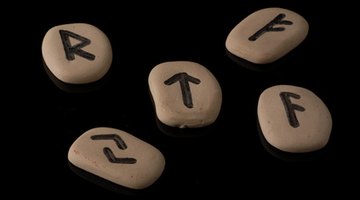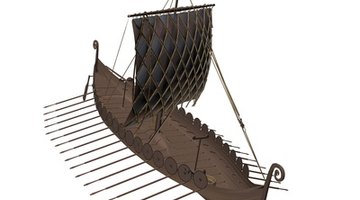Archaeologists have been uncovering Viking villages in several locations from Sweden to Canada. Each excavation reveals more information about the culture of these seafaring tribes. Vikings were warriors, traders and colonists. Your students can take online tours of Viking villages through sites like PBS or the BBC. Classroom projects can supplement your lessons on Vikings to make learning more interactive and interesting.

Teach students to write their names in Futhark, using Viking runes. Create a handout showing each of the Futhark runes, the sound it represents and its name. You can make your own handout from online sources such as NOVA Online or Ancient Scripts Online. You can also download a pdf of the alphabet at Lexicology. Have students make themselves a name tag using Futhark. Then have everyone bring their nametags up front. Calling up one student at a time, hand that student a nametag and ask her to find the person to whom it belongs.
- Archaeologists have been uncovering Viking villages in several locations from Sweden to Canada.
- Teach students to write their names in Futhark, using Viking runes.

Develop a list of important events in Viking history. Have students research to find when these events took place. Then have them create a timeline using a tree circle. Earlier events should be closer to the centre of the tree, while later events should be on the outer rings of the tree. Talk to students about how tree-dating is one of the ways scientists have dated things they find in Viking villages.

Provide older students with woodworking tools, wood and pieces of cloth. Divide them into teams. Have one team build a model of a Viking ship and a poster to explain how Vikings depended on their ships. Have a second team build a Viking meeting hall and a poster to explain how it was built. Have a third team build a model of a Viking dock and a poster to explain how it was built.
- Develop a list of important events in Viking history.
- Have one team build a model of a Viking ship and a poster to explain how Vikings depended on their ships.
Discuss with students the types of food that scientists think Vikings ate, based on what types have been found at Viking Village archaeology sites. Have students create a menu for a Viking feast.
Download the Viking Explorer game from the BBC. Divide students into groups of four to six. Give each group a copy of the game and explain the rules. Give students a half hour to an hour to play the game. Afterward discuss what they learnt about Viking culture from the game.
- Discuss with students the types of food that scientists think Vikings ate, based on what types have been found at Viking Village archaeology sites.
- Give each group a copy of the game and explain the rules.
Read a Viking saga to the class. Discuss the style of storytelling exhibited in the saga. Explain the importance of sagas to the Viking culture. Instruct students to write a Viking-style saga about the topic of their choice. Once the sagas have been written, have students deliver them in a speech the way the Vikings would have around the fires and in feast halls.
